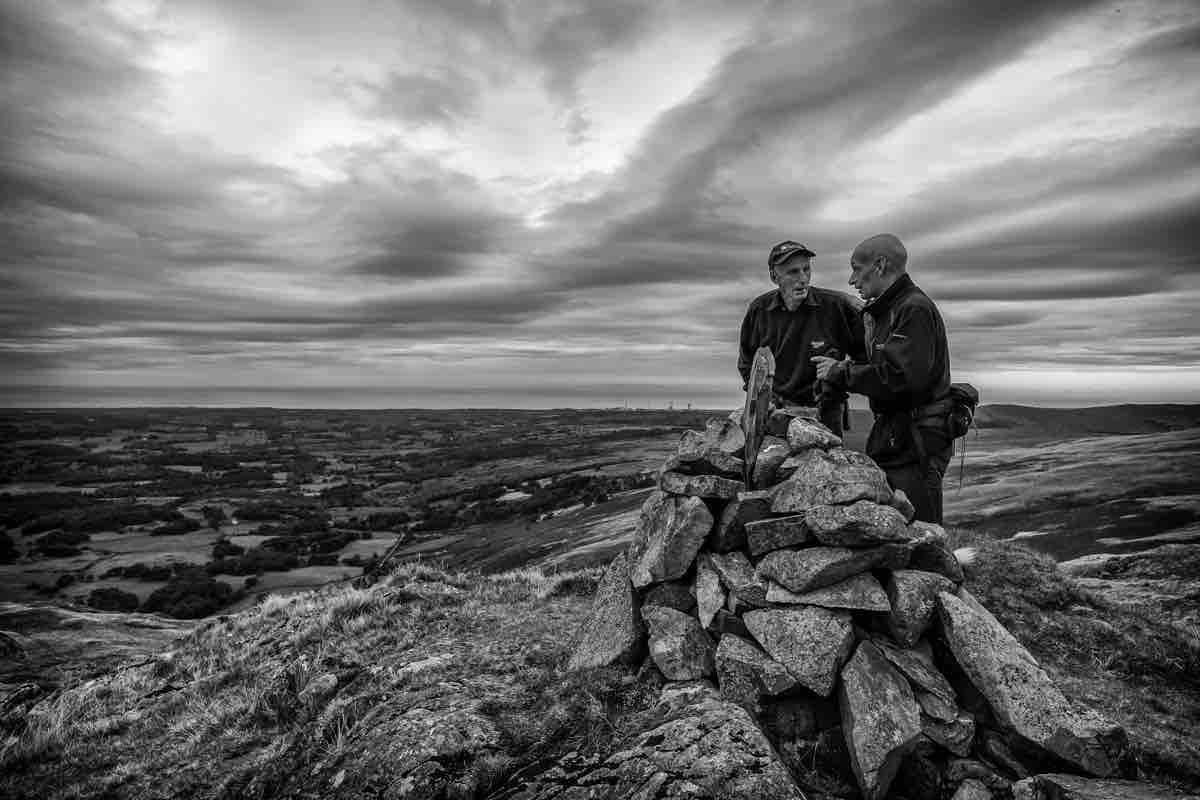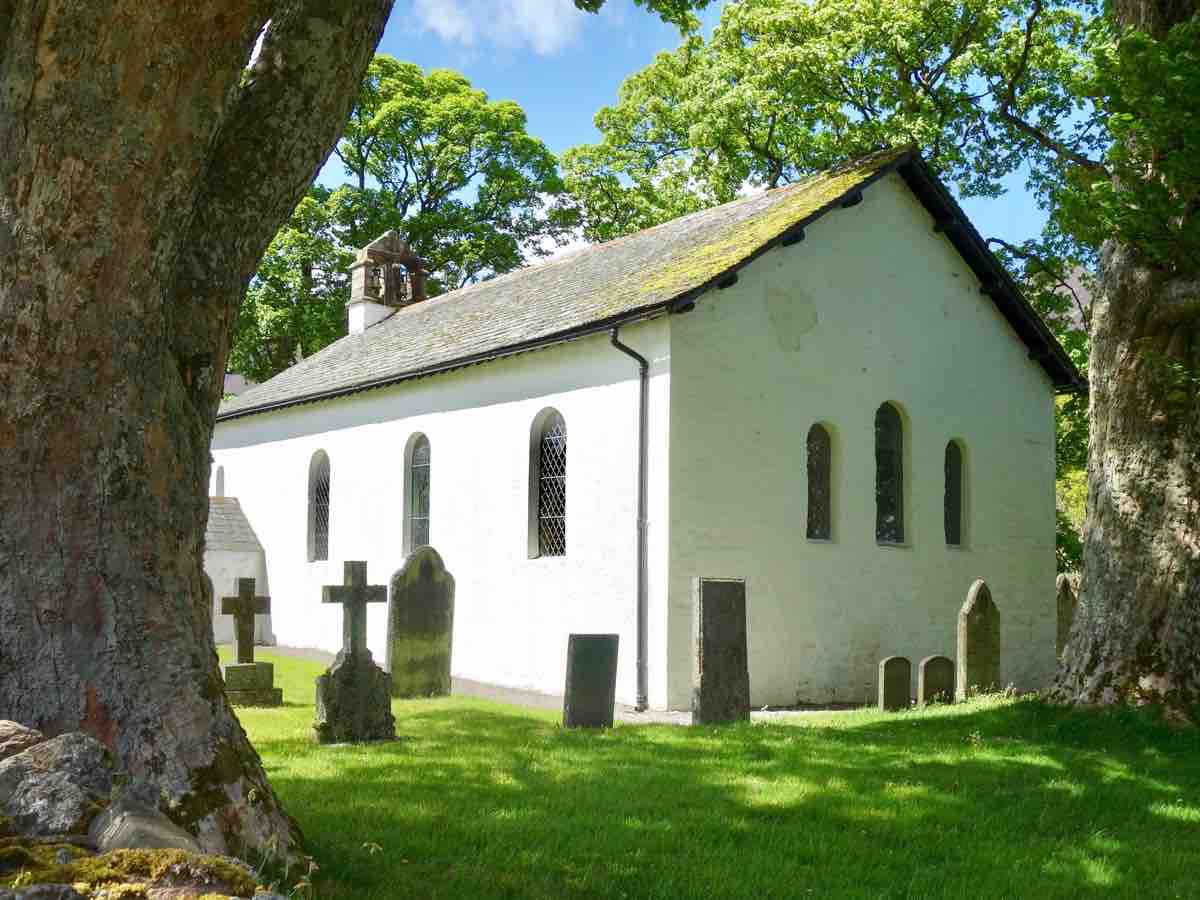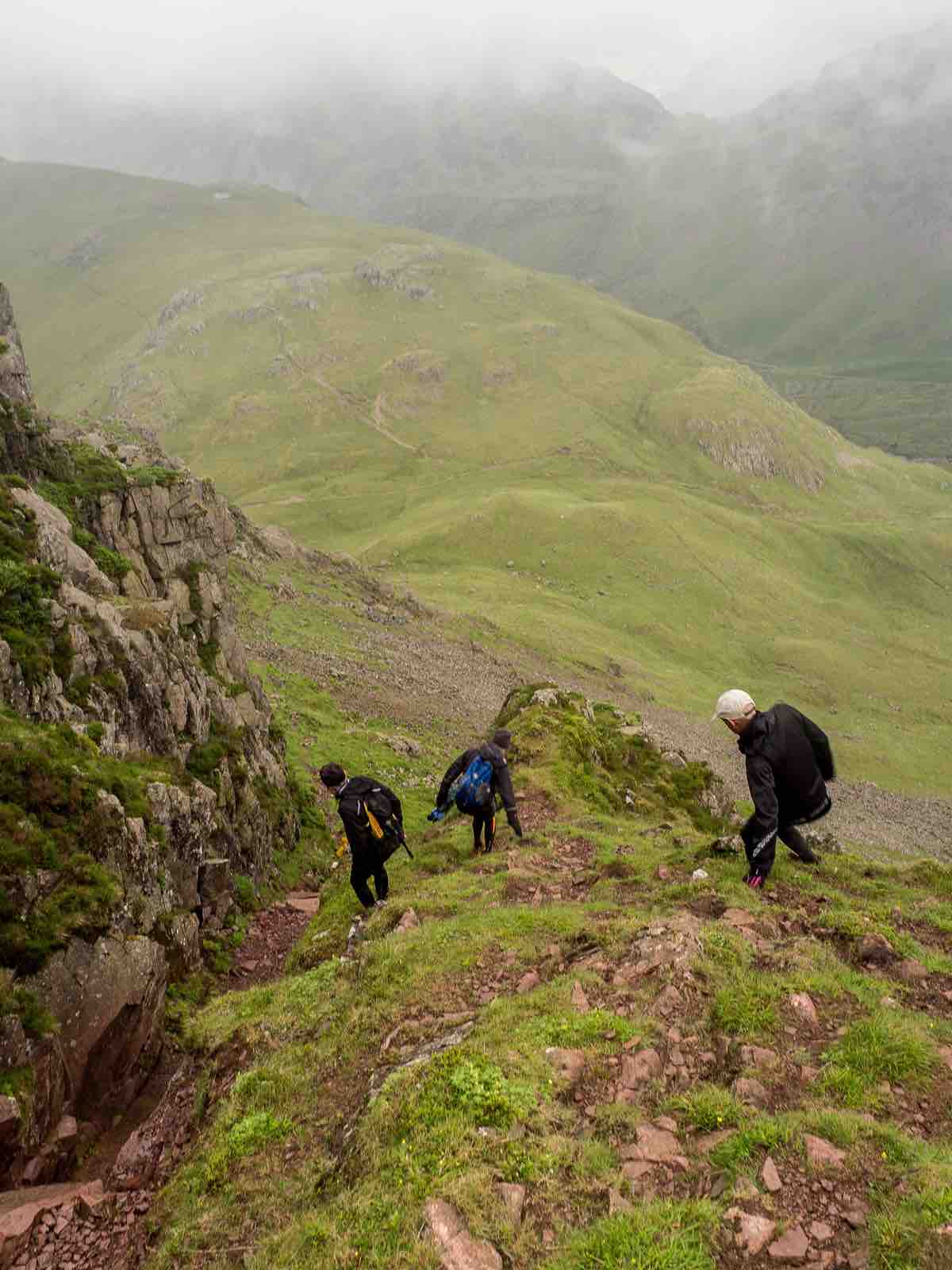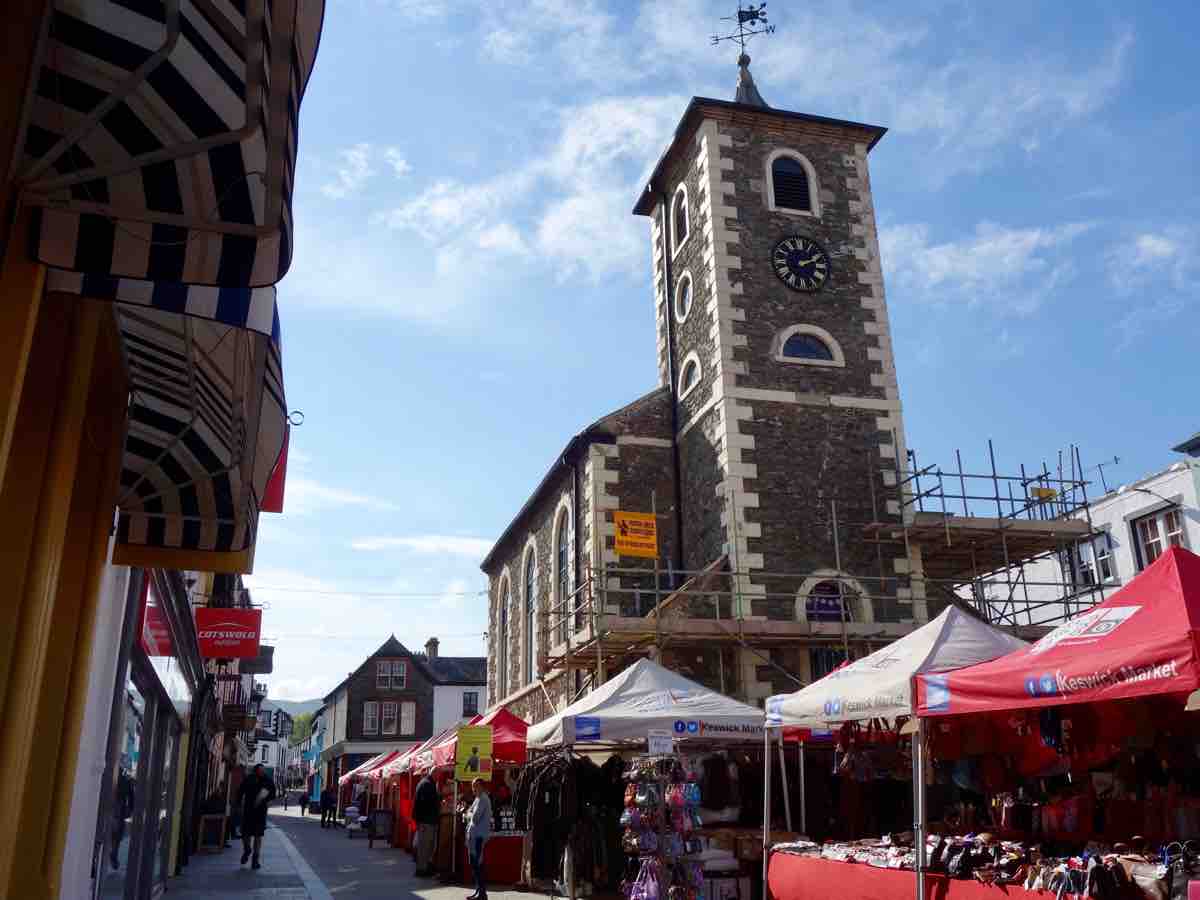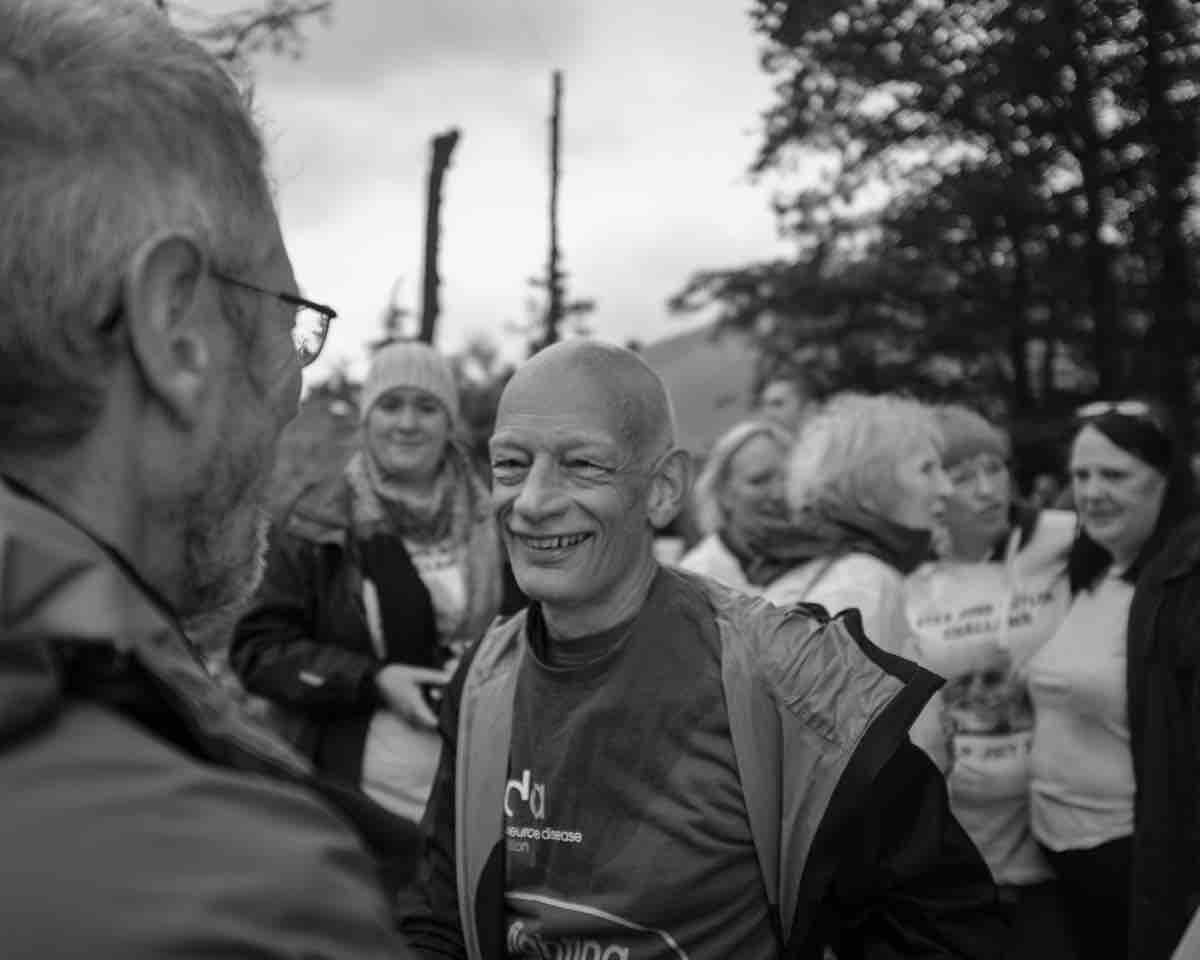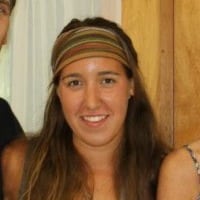[Editor’s Note: It’s with great sadness that we note that Steve Cliff lost his battle with motor neurone disease on January 11, 2018, and Wynn Cliff lost her battle with cancer on May 11, 2022. Though this pair’s legacy lives on in so many ways, they are missed.]
Before you read the rest of this article, sit back and close your eyes. Take yourself out of your land, your country, your office, your home, wherever you are. Imagine your feet planted on the grass and rocks of the fells in England’s Lakes District. There may be wind, rain, and fog, or there could be sun. You may find a trod, or you may face a trackless expanse. In your hands are a map and compass, and in your head a vision of how you might get from where you are to where you’d like to be next. You are a fell runner.
Today, you’re headed toward those peaks looming in the distance. You’re in the middle of a Bob Graham Round, one of the three most-well-known United Kingdom rounds of fell running, which can be explained as a hybrid of orienteering and mountain running done for the love of a self-timed, honor-based challenge.
To achieve the Bob Graham Round is to traverse the 66-mile, 27,000-feet-of-climb circuit of 42 peaks in the Lakes District of England in under 24 hours. There is also the Paddy Buckley Round, which treks over 47 peaks in 61 miles and with 28,000 feet of ascent over rougher terrain through Snowdonia in Wales. The third round, the Ramsay Round, is in Scotland and includes 24 summits while climbing about 28,500 feet over the span of 58 miles.
These challenges are not typically and traditionally done solo. Concerns of safety and considerations of camaraderie come into play. That is where Steve and Wynn Cliff can often be found. The pair has supported hundreds of attempts on the Bob Graham Round and the other two rounds.
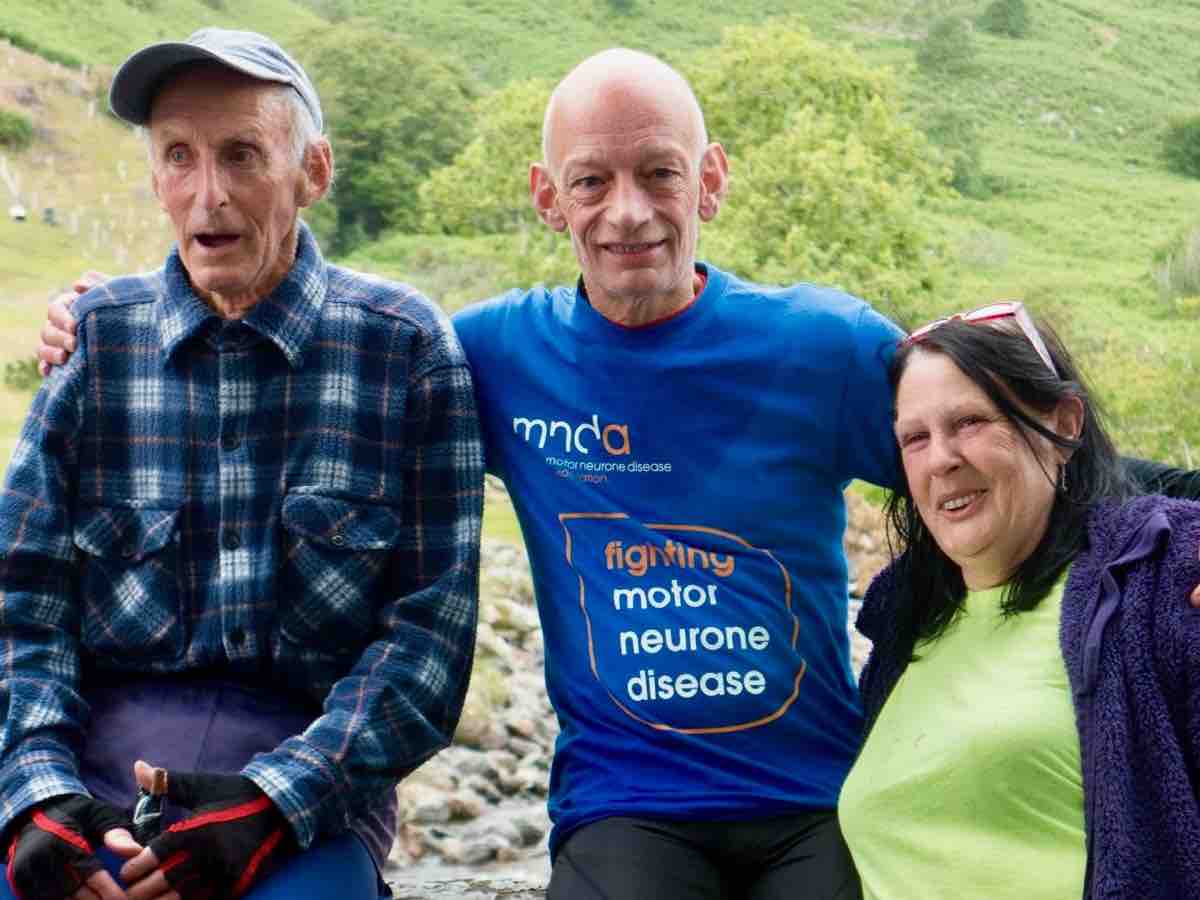
Left to right is Joss Naylor, Steve Cliff, and Wynn Cliff after Steve’s successful completion of the Joss Naylor Challenge in 2015. Photo: Ian Charters
When you enter the Bob Graham Round community, names and faces become familiar, Morgan Williams said.
Morgan became the Secretary of the Bob Graham 24 Hour Club nearly 12 years ago and works with hundreds of people attempting the round, their pacers, and their supporters.
The names Steve and Wynn Cliff continuously crop up each year. Steve’s pacing and and crewing support and Wynn’s crewing for some who attempt the Bob Graham Round are spoken of in hushed tones, he said, as if the magic of these two remain a secret.
“It quickly became clear to me that there was a calmness and a certainty about these two people that was impressive, at least to me,” Morgan explained. “This calmness I think arises from a deep commitment to the task in hand, from proper planning, from knowing the history of the Round, from years of participation in both fell running and Bob Grahaming at the sharp end. Put simply, they are both stunningly good at what they do.”
Steve and Wynn Cliff are legends of fell running and round running in the U.K., epitomizing the spirit of the sport. Their tireless support for the community and the challenges its members undertake seems to be understood, appreciated, and honored by everyone who has met them.
So who exactly are Steve and Wynn? Just two people who fell in love with each other, with the sport of fell running, the Bob Graham Round, and the people who undertake these challenges? Yes, they are those things–and more. They are two people who keep going strong together, while inspiring others to do the same.
Steve and Wynn Cliff have been married for 21 years, celebrating their marriage ceremony at the Newlands Church, located in the Newlands Valley of the Lake District. Steve grew up in Liverpool and Wynn in Manchester and they now live outside of a village called Shap in the eastern Lake District.
Steve worked in financial services in the banking industry, working globally for years, which, he says, “broadened his horizons.” Wynn held a few jobs, but mainly took care of their two daughters who have brought into the Cliff family nine grandchildren and one great-granddaughter. She now works full time caring for Steve.
Steve is the runner in the family. He started running in 1976 as a way to kick the smoking and drinking habit, he claimed. He stuck to the roads for a few years–reaching a 2:36 marathon best–until a good friend named John Wright began taking him on longer and longer runs.
“It was after I started fell running around 1978 when I discovered ultrarunning,” he said. “I was doing huge distances (13 and more miles, which was huge then), which then developed into longer runs in the early ‘80s.”
His first ultra-distance race was Yorkshire’s Lyke Wake Walk, in which he finished in third place.
“This is 40 miles across the North York Moors and I loved every minute of it. Using my marathon speed, we started by doing six-minute miles and covering ground,” he said. “The landscape changed so quickly, the freedom of the run, the friendliness of fellow competitors and marshals… it was all there, and so different from the road races that had been my bread and butter.”
In 1992, he trained for his first Bob Graham Round, which he finished in 21 hours.
These rounds are not considered trail or ultrarunning, instead considered as fell running.
“’Fell’ is a term for a high and barren landscape,” he explained.
Trail running involves traveling defined trails, while fell running involves covering the open ground with no defined route. Perhaps more importantly, fell running requires route-finding and navigation skills—the abilities to onsite efficient lines and to use a map and compass to progress even if the Lakes’s frequent bad weather obscure your views of the terrain.
The Bob Graham Round originated in 1932 when a Keswick man—Bob Graham, obviously—made its first loop, finishing in just under 24 hours. The feat has now become popular, largely among British fell runners and trail runners and more recently by international mountain runners, and has now been repeated a couple thousand times.
The Bob Graham Round 24 Hour Club was established, according to its website, “to promote safe long distance traverses of the fells and its main activity is the administration of the [Bob Graham] Round itself.” While some who attempt the round do so unofficially, those who would like to be a part of the club, explains the website, “must register with the Membership Secretary before an attempt and must be accompanied at every summit for verification purposes. It is one of the traditions of the Club that existing members will assist their aspiring colleagues by ‘pacing’ their attempts.”
For example, in 2016, the Bob Graham Round 24 Hour Club received 166 registrations, and 79 of those registrants finished in under 24 hours.
This challenge, to fit in all 42 summits in one day in a loop, starting and finishing at Moot Hall—an assembly hall turned tourist center originally built in 1571 (it’s been rebuilt a couple times since)—in Keswick, where Bob Graham himself did the same, is not easy. The long day of hills with a lot of ascent and descent, the ever-changing weather, and the mental focus all this requires, set the average success rate at 40 to 50 percent.
With help from the Cliff crew, that success rate shoots up to 95 percent.
“We have helped over 100 Bob Grahams and in addition, many Paddy Buckleys and a few Ramsay Rounds,” Steve said. “Wynn does the road support, and I have paced and navigated sections of the course.”
Leading up to this feat requires planning. Along with the physical training, Steve said, you must believe you can do it.
“It helps if you know the route, can build a mental picture of what is ahead, and break it down into bite-sized chunks.”
When you’re on the round with the Cliffs on your side, all you have to do is run.
“The whole day is about getting one person around the course in their target time. In reality, it is about the whole team achieving the goal,” Steve said. “By the end of the day, it feels like they have bared their souls for the world to see, and to achieve and finish against what seems like all odds is just a great feeling.”
Steve describing this course is beautiful. To him and many Bob Graham Round devotees, this is not just a running exploit to conquer. It is an experience that infiltrates the rest of your life.
In Morgan’s words: “For a select few, a Bob Graham sits in their comfort zone. For many of us, it is one of our key achievements in life, right at the edge of what we can do. To have help and support when times get tough, and they do for Bob Graham contenders often for hours at a time, is a very human need and the Cliffs have a huge understanding of this and deep knowledge of how to help people find a way through the tough points, whether it is Steve on the fell or Wynn at the road-crossing points.”
Steve described what’s referred to as Leg 1 for those who attempt the round in the clockwise direction, “When the skylarks rise into the sky, creating a perfect melodic tune as you come over the crest of the final hill [to summit Blencathra] and the sun peeps over the horizon across the Hall’s Fell Ridge…” he described. “I say this is my favorite but, but every section has its great moments.”
Wynn looks at crewing as a job. It is her job to support runners with food, drinks, and supplies, while making sure there is no whining, complaining, or stopping by the those who’ve chosen this voluntary adventure.
“I am a good organizer–read ‘bossy boots’–and my role tends to be mummy, motivator, problem solver, caterer, and first aid,” Wynn explained.
Her strong personality is a reason many of the runners she supports get to the finish, otherwise, face her punishment. Many a Bob Graham Rounder has said that the physical challenges of finishing a round are far easier than the mental challenge of facing Wynn upon quitting it.
Ian Roberts, a member of the Bowland Fell Runners from the Forest of Bowland area south of the Lake Distruct, is a 20-plus year friend of the Cliffs.
In an email, Ian recounted,“ Wynn… does not mince her words. In 2006 on his first BG attempt, Bowland member Duncan Elliott arrived in Wasdale [one of the round’s road crossings where runners receive crew support] well down on his 23.5-hour schedule and utterly knackered. Wynn fed, stripped, washed, and redressed him, and then:
Wynn, ‘Right Dunc, off you go up that hill.’
Dunc, ‘No, I’d just be wasting everyone’s time.’
Wynn, ‘Duncan, just get yourself up Yewbarrow[, the next mountain].’
Dunc, ‘No Wynn, it’s just not going to happen.’
Wynn, ‘Duncan, will you F— off up that hill.’
Dunc, ‘No way, I not budging until you ask politely.’
Wynn, ‘Okay, please F— off up that hill.’
“At this point Dunc reckoned that five or six hours staggering over the tops to Honister[, the next road crossing,] was a better bet than two hours in a car with Wynn giving him earache. He arrived at Honister with about one hour remaining of his 24[, several hours short of what he’d need to finish the whole round in time]; and Wynn allowed him to retire gracefully. It certainly spurred him on to a complete round in 2007.”
The Cliffs give so much of their own time and efforts, so much of themselves to this round and to fell running in general, that one day, it gave something back. For years, Wynn has stood at the little white church that sits off to the side of the final hill on Leg 5 during a clockwise round, which leads to a five-ish-mile road run back to Moot Hall in Keswick. For years, she has watched the fading lights of the runners pass this church, heading toward the finish point.
So, it was at this Newlands Church overlooking the Newlands Valley, after years in a long-term relationship and at a place Wynn and Steve had both grown to love, where they tied the knot of marriage on April 20, 1996.
Since then, the two have directed their own series of races on their anniversary called the Anniversary Waltz Fell Race, which was just held for this year on April 22 and which starts and finishes in the Newlands Valley. They celebrated with some 1,000 runners across all of the race’s events, including some 445 finishers of the 11.5-mile course with 3,600 feet of gain through the mountains that surround the church. The weekend also includes a 15.4-mile race with 7,600 feet of ascent called the Teenager With Altitude Race and the Junior Race, composed of varying age-graded courses.
[Editor’s Note: The Anniversary Waltz was retired following its April 2018 edition.]
Coming back to where we started, that in-the-moment feeling of standing upon the grassy fells of the Lakes District, with the peaks encircling you and that little white church in your own hopeful future, I want to remind you to thank it, accept it, and understand the history behind it.
Sometimes we take this sport for granted. We answer, “Oh, just another 20 miler this weekend,” to our work colleague. Or, “It’s just running.” That is my go-to phrase, “It is just running.” But it is not. It–whether trails, roads, or fells–is more than just a sport. It is a sport that brings life and breeds love. And it’s also a thing that can be taken from you at any time.
Steve’s running is slowly being taken from him, yet the power of this community and the history of running in the U.K. has motivated Steve in more ways than can be documented here. Several years ago, Steve experienced a rapid and significant decline in his health. In 2014, he was diagnosed with celiac disease. Once off gluten, all that energy that had been missing for years came back to him, he said. Yet, in that year, he started to experience other odd manners, particularly with his speech, such as the slurring of his words. The following year, in April, now a little more than two years ago, he was diagnosed with progressive bulbar palsy, a form of motor neurone disease similar to amyotrophic lateral sclerosis. He was given 18 months to live by his first consultant.
Motor neurone disease (MND) is a rare disease affecting only two in 100,000 and has little research into it.
“The impact of a diagnosis of MND on oneself, friends, and family cannot be explained,” Steve wrote in a message. “It forces decisions to be squared up that one only ever expects to have to face in the darkest of moments. It draws closure to everything. However, my strong family support, fantastic friends, and focused approach to life meant that I very soon wanted to make a difference and to use time wisely.”
Steve knew he could not survive one day of living with his head hung low due to this disease, he said.
“I had to take the view that we have always had: ‘Running on life,’” he said. “So why stop now?”
July 18, 2015, a few months post-diagnosis, Steve attempted the Joss Naylor Challenge. Another personal-adventure challenge developed in 1990 by fell-running legend Joss Naylor, it is a point-to-point route that’s 48 miles long, hits 30 summits, and involves 17,000 feet of climbing. Generally undertaken by fell runners age 50 and older, there are age-graded and gender-graded finishing standards. Men between the ages of 55 and 60 are given 15 hours to complete the challenge. On that atrocious weather day in July and at age 58, Steve finished in 13.5 hours. He was pleased with his time and his ability to finish, which was never a factor in his mind, but he was more pleased with the amount of money he raised for research on and awareness he spread about MND.
The idea to complete the Joss Naylor Challenge had been in the back of his head, a “bucket-list” type of thing, he said.
“Joss Naylor is a longtime hero of mine,” he explained. “For years I raced against him, and only once ever managed to beat him.”
That was one reason to start the challenge, the other was simply knowing that he could do it.
“The other thing that pushed me to a challenge was that I realized how fortunate I was for having a lot of great friends and family around me to cushion the blow of the news of such a terrible disease,” he explained. “I read so much about others who didn’t have that support structure. I wanted to do something for them.”
The disease has severely affected Steve’s speech, now making talking impossible. Instead, he writes.
When preparing to start the Joss Naylor Challenge he wrote to those supporting him: “The purpose of this run is to make money for the Motor Neurone Disease Association, so to that end… I want NO sympathy, NO being nice. If I look like I am becoming ‘tired and emotional’ then give me a kick and tell me to pull myself together.”
He was focused, but it was hard. Headwinds, cold temperatures, big ascents, and steep descents hit him the entire way. Babying those muscles that would soon be affected by the disease was also a constant struggle.
“MND was always somewhere lurking in my mind, but amongst these beautiful mountains, even that ogre can get lost now and then,” he said.
Crowds of applause and support met him and his pacers throughout the course and at the finish line, including Wynn and his family.
A future goal Steve made two years ago is to attempt the challenge again at 60 years old, but the questions of “Is this right for me?” Is this the right time?” have started to come into mind, especially with the disease taking a large toll on him over the last year, he said.
If Steve can’t run the challenges himself anymore, he still considers there to be many ways to participate in and give back to the world around him. Continuing to raise money for charity: yes. Organize a race for other runners: yes. Get more involved with supporting the sport: yes, with his secretarial position for the Fell Runners Association.
When it came to MND, it was different because it was now more personal.
“For MND, I wanted to raise funds, but also a huge thing is raising awareness,” he said. “I can see a day in the future when there will be adequate funds to look after patients, friends, and family of those with this terrible disease; and probably not in my time, when MND will be curable.”
Steve accepts that his path on earth is different from others’, but he will also agree that it’s sad to think about things he isn’t able to do anymore, now and in the future.
When that first celiac-disease diagnosis came, Wynn was just happy the problem was solvable. When the next blow came, a bigger effort than just making the house gluten free was required.
“When he started to slur his words, I thought he was just tired and overworking,” Wynn explained. “But not so. The bombshell of MND knocked us both sideways and a very fast learning curve gave us details no one should have to face.”
When the Joss Naylor Challenge came up, Wynn was ready to become challenge supporter once more. She received word from 80 people who wanted to come out and ‘play’ with Steve on the trails, she said.
As Steve experiences more problems with eating, drinking, and his speech, Wynn admits she gets more worried for him being out on his own for runs.
“But the options are to try to wrap him up in cotton wool or man up and support him,” she said. “I have a saying, ‘Deep breaths, shallow thoughts, and big-girl knickers.’ I love the bones of this man. He is my best friend, my other half, and we will grab what we can for as long we can and see where it takes us.”
Steve continues to raise money for MND. This week, he surpassed the £250,000 mark and was invited to and attended a garden party hosted by the Queen of England at Buckingham Palace in London in acknowledgement of his MND fundraising and awareness-raising efforts. [Editor’s Note: This is the Just Giving fundraising campaign from Steve’s Joss Naylor Challenge, which Steve has kept open to facilitate donations. You can support Steve’s fundraising efforts there.]
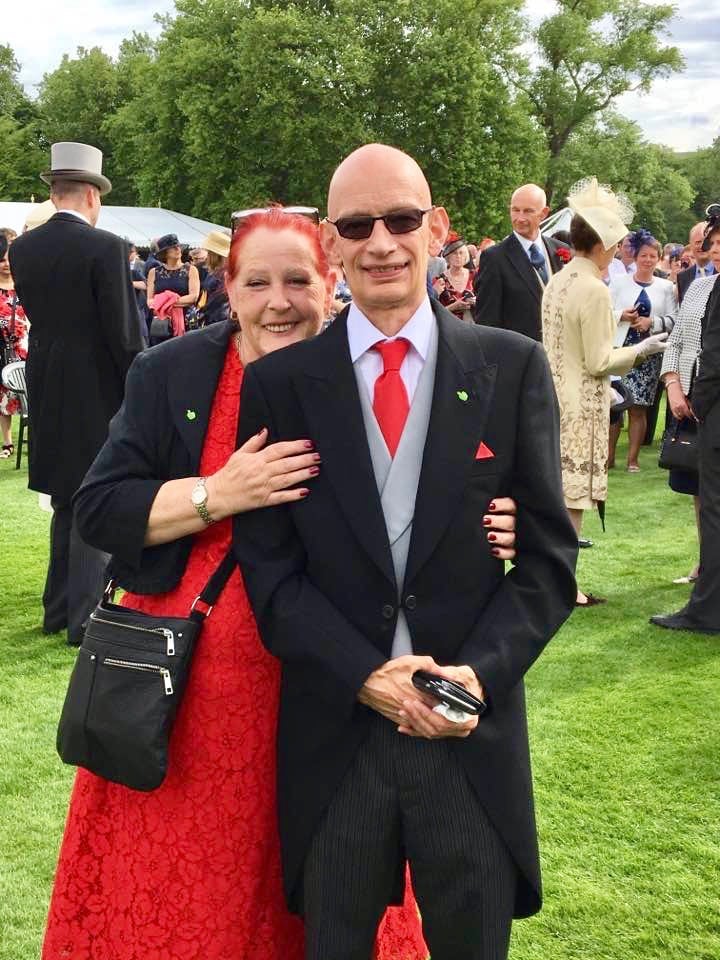
Wynn and Steve at the garden party hosted by the Queen of England at Buckingham Palace in London earlier this week. Photo courtesy of Steve and Wynn Cliff.
This weekend, Steve and Wynn (and Morgan, too) will play Bob Graham Round supporters once again, this time to a runner hailing from outside the fell-running community, iRunFar’s own Meghan Hicks. While Steve is physically unable to pace Meghan on the fells as he has dozens of times in the past, he will join forces with Wynn at the round’s four road crossings to support Meghan and the crew of pacers the Cliffs have assembled to aid her as she attempts an under-24-hour finish of the Bob Graham Round.
Explained Meghan, “I am not from here and just learning the art of fell running, but Wynn and Steve have welcomed me into their home, onto their fells, and into their tribe as one of their own. To this couple, I can only imagine how precious every moment of every day is. It is the highest of honors that they would dedicate their time to me.”
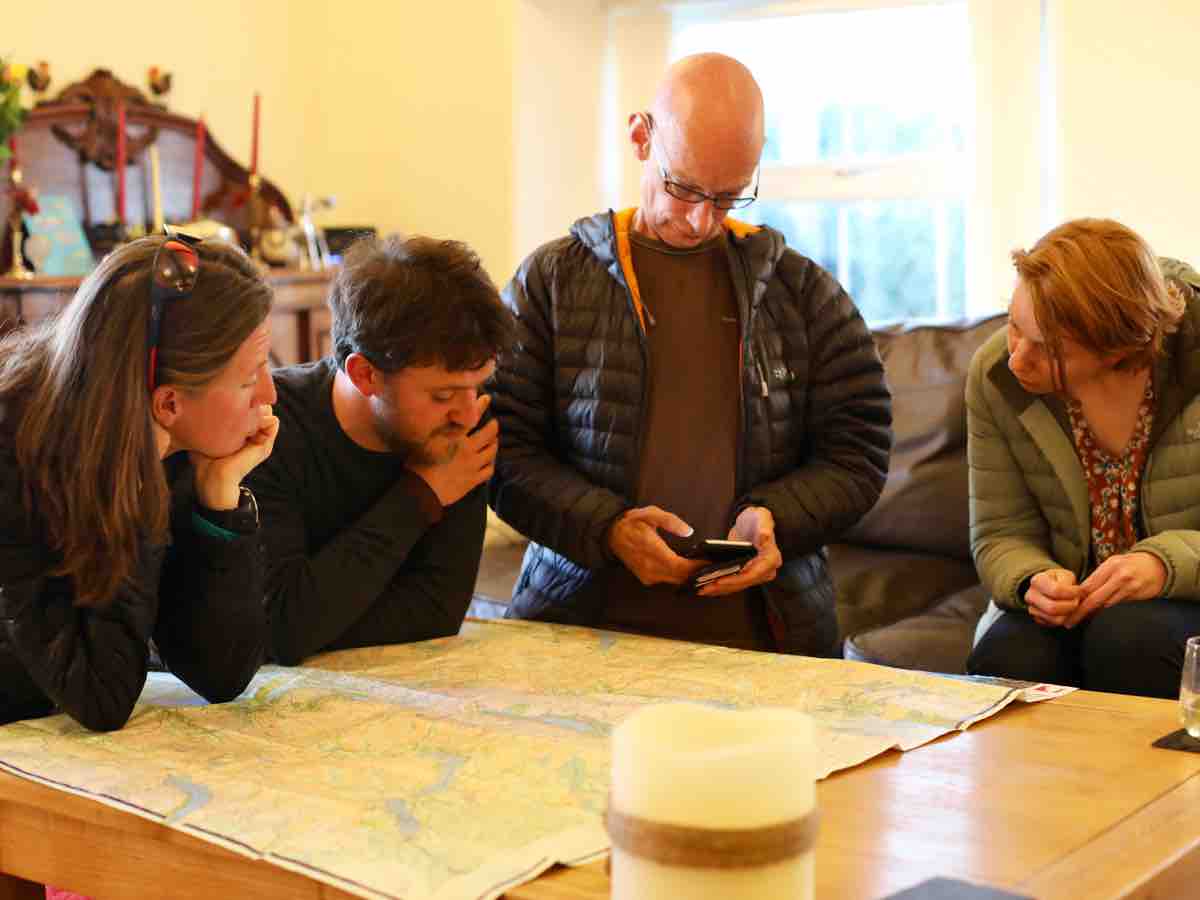
Steve using an app on his phone to communicate while poring over a map of the Lake District with (left to right) Meghan Hicks, Joe Williams, and Caroline Holmes. Photo: iRunFar/Bryon Powell
This film short by West Pictures, made public just a few weeks ago, provides a brief but intimate window into the current world of Steve and Wynn, and the heartbreaking life journey they now face.
Before, when Steve thought about “life’s bucket lists,” it was images of races, heading to sandy beaches, and hiking up mountains.
“All of these thoughts continue, however, I now realize that all is nothing without friends and family,” Steve said. “The love of friends and family is a great solace and healer of wounds. My bucket list is greatly simplified.”
Call for Comments (from Meghan)
Do you know Steve and Wynn Cliff? Have you been supported by them on an attempt of one of the U.K.’s rounds? Or have you run their race? Leave a comment to share your story about the Cliffs.
